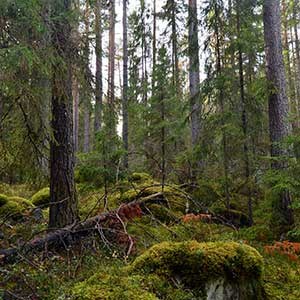Contact
julia.kyaschenko@slu.se

When stands of Scots pine age, the microbial community composition changes. Clear-cutting has a negative effect on ectomycorrhizal fungi, something that is negative for the recycling of organic nutrient pools in the soil, and therefore for the long-term forest production.
Old-growth coniferous forests in Scandinavia are usually composed of trees of different species and ages, but today most forest areas are managed into even-aged stands. This has major effects on biodiversity and potential impacts on carbon storage. In addition, the microbial community composition in old-growth stands are likely to differ from managed forests.
In a new study from the Department of Soil and Environment and the Department of Forest Mycology and Plant Pathology, SLU, researchers have investigated ten even-aged Scots pine stands with tree ages ranging from 1 to 158 years. The looked at both community composition in different organic layers and at correlations between community shifts along the age gradient and activity patterns of extracellular enzymes.
– Not surprisingly, we found that clear-cutting had a negative effect on ectomycorrhizal fungal abundance and diversity. Saprotrophic fungi correlated with enzymes involved in decomposition of wood became, in contrast, more numerous with clear-cutting, says Julia Kyaschenko, one of the researchers behind the study.
When the Scots pine stands age, the community of ectomycorrhizal fungi shifted in composition. Younger stands were dominated the group Atheliaceae, while older stands were dominated by species from the groups Cortinarius and Russula. These species from the older stands were correlated with enzymes that are involved in degrading organic matters. This indicate an increased nutrient limitations in the soil.
– If forests were managed differently, for example with continuous cover forestry, this could better maintain the balance between saprotrophic and mycorrhizal fungi. By preserving ecologically important species such as Cortinarius and Russula, the organic nutrient pools could be recycled throughout the forest rotation. This would be very beneficial for long-term forest production, says Professor Björn Lindahl, another researcher behind the study.
julia.kyaschenko@slu.se
Read the full study in the ISME journal here: http://www.nature.com/ismej/journal/vaop/ncurrent/full/ismej2016184a.html